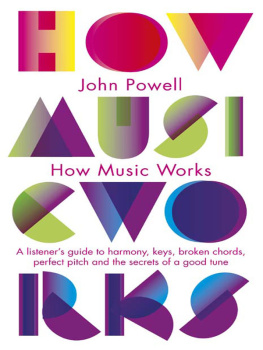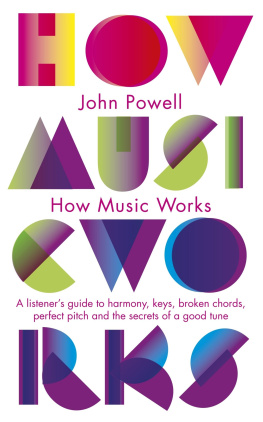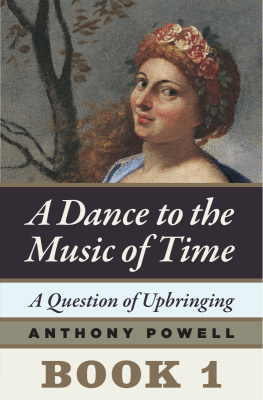John Powell - How Music Works
Here you can read online John Powell - How Music Works full text of the book (entire story) in english for free. Download pdf and epub, get meaning, cover and reviews about this ebook. publisher: PENGUIN BOOKS UK, genre: Children. Description of the work, (preface) as well as reviews are available. Best literature library LitArk.com created for fans of good reading and offers a wide selection of genres:
Romance novel
Science fiction
Adventure
Detective
Science
History
Home and family
Prose
Art
Politics
Computer
Non-fiction
Religion
Business
Children
Humor
Choose a favorite category and find really read worthwhile books. Enjoy immersion in the world of imagination, feel the emotions of the characters or learn something new for yourself, make an fascinating discovery.
- Book:How Music Works
- Author:
- Publisher:PENGUIN BOOKS UK
- Genre:
- Rating:3 / 5
- Favourites:Add to favourites
- Your mark:
- 60
- 1
- 2
- 3
- 4
- 5
How Music Works: summary, description and annotation
We offer to read an annotation, description, summary or preface (depends on what the author of the book "How Music Works" wrote himself). If you haven't found the necessary information about the book — write in the comments, we will try to find it.
How Music Works — read online for free the complete book (whole text) full work
Below is the text of the book, divided by pages. System saving the place of the last page read, allows you to conveniently read the book "How Music Works" online for free, without having to search again every time where you left off. Put a bookmark, and you can go to the page where you finished reading at any time.
Font size:
Interval:
Bookmark:
At various points in the book I have mentioned that the jump in pitch between any two notes is called an interval. The interval we have discussed most is the octave the jump in pitch that corresponds to a doubling of the frequency of vibration of the note. All the other intervals also have names, some of which I have referred to already. The table overleaf presents a list of interval names along with the size of the interval in semitones. You can also see three photos of a pianist playing two notes a fourth apart. In each case we start on any lower note and count up to the note which is five semitone steps higher (counting the black notes as well as the white ones). I have included three illustrations here in order to make it clear that it doesnt matter which note you start on the one five semitone steps up will always be a fourth higher, and similarly the one nine semitones up will always be a major sixth higher.
After years of musical training you get to recognize each of these intervals and you can write down any tune which comes into your head (start on any note, up a fifth, down a major third etc.). But there is a way of identifying musical intervals which anyone can manage. All you have to do is learn the names of the intervals which occur at the beginning of several songs. I have made a list of suitable songs in the table below. The first two notes of the songs identified in this list give you the interval in its rising form (unless I have stated otherwise). Most tunes start with a rising interval, so examples are plentiful and you might want to substitute other songs for your own list. You might also want to collect twelve descending intervals from other songs.
So now, when youre bored, sitting at an airport, you can identify the interval of whichever annoying bing bong noise they are using by matching it to one of these songs.
Size of interval | Name of interval | Song to identify rising interval |
1 semitone | minor second or semitone | I left my heart in San Francisco |
2 semitones | major second or tone | Frre Jacques or Silent night |
3 semitones | minor third | Greensleeves or Smoke on the Water (by Deep Purple) first two guitar notes |
4 semitones | major third | While shepherds watched their flocks by night or Kum ba yah |
5 semitones | fourth | Here comes the bride or We wish you a merry Christmas |
6 semitones | diminished fifth (or augmented fourth) | Maria from West Side Story |
7 semitones | fifth (or perfect fifth) | Twinkle twinkle little star (the jump between the two twinkles) |
8 semitones | minor sixth (or augmented fifth) | The theme from Love Story begins with this interval falling then rising |
9 semitones | major sixth | My bonnie lies over the ocean |
10 semitones | minor seventh | Somewhere from West Side Story |
11 semitones | major seventh | Take on me (song by the band a-ha) |
12 semitones | octave | Somewhere over the rainbow from The Wizard of Oz |
13 semitones | minor ninth | |
14 semitones | major ninth | |
15 semitones | minor tenth | |
16 semitones | major tenth | |
17 semitones | eleventh (or an octave and a fourth) |

Three photos of a pianist playing two notes a fourth apart. It doesnt matter which note you start on the two notes are always separated by a gap of five semitones.
1. The decibel system is a method of comparing the difference in volume between two sounds. These differences are measured in the following way:
If the difference between two sounds is 10 decibels then one sound is twice as loud as the other.
If the difference is 20 decibels then one sound is 4 times as loud as the other.
If the difference is 30 decibels then one sound is 8 times as loud as the other.
If the difference is 40 decibels then one sound is 16 times as loud as the other.
If the difference is 50 decibels then one sound is 32 times as loud as the other.
If the difference is 60 decibels then one sound is 64 times as loud as the other.
If the difference is 70 decibels then one sound is 128 times as loud as the other.
If the difference is 80 decibels then one sound is 256 times as loud as the other.
If the difference is 90 decibels then one sound is 512 times as loud as the other.
If the difference is 100 decibels then one sound is 1024 times as loud as the other.
If the difference is 110 decibels then one sound is 2048 times as loud as the other.
If the difference is 120 decibels then one sound is 4096 times as loud as the other.
2. When using rule 1 (above) it doesnt matter which decibel number you start on. For example, the difference between 10 decibels and 20 decibels is 10 decibels so 20 decibels is twice as loud as 10 decibels. But the difference between 83 decibels and 93 decibels is also 10 decibels so 93 decibels is twice as loud as 83 decibels. Similarly, 72 decibels is 16 times as loud as 32 decibels (because the difference between 72 and 32 is 40 decibels).
3. Although the decibel system should only be used to compare the relative loudness of two noises (as in rules 1 and 2 above), many people use decibels as a definite measure of the loudness of a single noise. In this case they are not saying a large bee creates a noise of 20 decibels; what they are actually saying is a large bee creates a noise which is 20 decibels louder than the quietest noise we can hear. The quietest noise we can hear is called the threshold of hearing, so we are really saying a large bee creates a noise which is 20 decibels louder than the threshold of hearing. When people appear to be using decibels in a non-comparative way (e.g. The loudness of that motorbike is 90dB) its just because they havent bothered to include the phrase louder than the threshold of hearing its taken for granted.
If you are doing this as an experiment it would be convenient to use a guitar, as its the commonest six-string instrument. On a guitar, the strings are traditionally numbered 1 to 6 with 6 being the thickest one and the lowest note. Unfortunately, this is the opposite of the numbering system I used in , and once using the traditional guitar numbering for the strings. You can use either set of instructions they both give exactly the same result.
If you tune a guitar to a pentatonic scale, you will change the difference between the thickest string and the thinnest from two octaves to one octave. If you make the thickest string give its usual note before you start, this will mean that the thinner strings will be very slack by the time you have finished. This doesnt matter much if you are doing this out of curiosity and you are going to return the guitar to its normal tuning in a few minutes. If, on the other hand, you are doing this as a long-term plan or as a demonstration for students, Id recommend that you tighten the thickest string to give a higher note before you start and/or change the thinner strings for thicker ones.
Font size:
Interval:
Bookmark:
Similar books «How Music Works»
Look at similar books to How Music Works. We have selected literature similar in name and meaning in the hope of providing readers with more options to find new, interesting, not yet read works.
Discussion, reviews of the book How Music Works and just readers' own opinions. Leave your comments, write what you think about the work, its meaning or the main characters. Specify what exactly you liked and what you didn't like, and why you think so.










